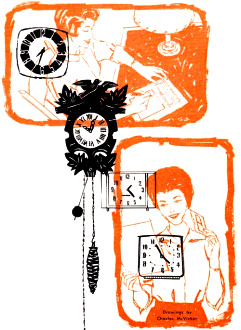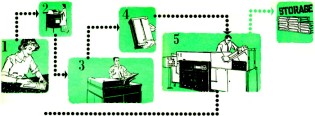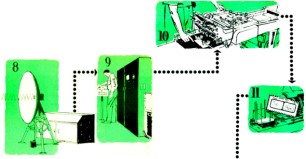|
April 1961 Popular Electronics
 Table
of Contents Table
of Contents
Wax nostalgic about and learn from the history of early electronics. See articles
from
Popular Electronics,
published October 1954 - April 1985. All copyrights are hereby acknowledged.
|
Electronic mail did not start
out as we know it today, whereby anyone with access to an Internet-connected device
can compose and send a typed message to a similarly equipped receiver. The first
electronic mail message was sent (and received) on November 1, 1960, between post
offices in Washington, D.C., and Chicago, Illinois. This article from Popular
Electronics magazine takes you on a step-by-step tour of how the Speed Mail
system worked, including its dedicated shortwave radio links between participating
cities. Great care was taken in an attempt to assure message confidentiality by
having the letter opened and scanned automatically inside a sealed machine on the
transmit end and then printed and placed in a sealed envelope on the receive end.
Knowing what we know now about government snooping, you have to wonder if a copy
of each message was routed to the NSA (formed in 1952).
Here is a brief accounting of
electronic mail services (and
here).

The thumbnail image here shows the very first Speed Mail envelope sent on November
1, 1960:
Dear Mr. Schroeder:
These greetings--by Speed Mail--mark another mile post in our mutual effort to
bring new and swift postal service to the people of the United States.
Transmitted in seconds, communications such as these will give additional meaning
to the program of next day delivery of mail anywhere in the United States.
To our friends in Chicago, we express the thanks of all of us in Washington for
the unstinting aid and support which has been given us. And our friends of the press
corps in Washington send their greetings to the press in Chicago.
Sincerely,
Arthur E. Summerfield
Postmaster General
Electronic Speed Mail
 By Ken Gilmore By Ken Gilmore
Speeding trains and transcontinental jets fade into oblivion as the U. S. Post
Office turns to electronics to meet the challenge of the space age
Last November 1, the Postmaster General gave the signal that put into operation
one of the most revolutionary systems in the history of the Post Office Department.
At the signal, a letter was inserted in a machine in Washington, D. C. Three seconds
later, another letter, identical to the one in Washington, popped out of a machine
in Chicago.
Hundreds of other letters - all official government mail - followed at the rate
of one every four seconds for each pair of sending and receiving machines. Since
there were four such pairs operating in each direction, letters flowed at the rate
of one every second between the two cities. The long-awaited age of "Speed Mail"
- the Post Office Department's name for this brand-new service - had begun.
Actually, the November operation was only a test. Although some 40 government
agencies transmitted large amounts of official mail to check the system's capabilities,
you can't send letters by Speed Mail - yet. And you probably won't be able
to for two or three years. But the experiments last fall did prove beyond the shadow
of a doubt that the system is entirely practicable.
If present plans work out, "Speed Mail Centers" will be established in the country's
71 largest cities. Such a system would mean same-day or next-day delivery anywhere
in the country. The limiting factor, of course, will be the time required to handle
the mail at each end-pickup and delivery to the local post office at the sending
end, local delivery at the receiving end. The actual transmission to the next state
- or across the country - will take only a few seconds.

Let's see - step-by-step - just how Speed Mail will work. Say you live in Washington,
D.C., and want to send a letter to a friend in Chicago. Within a few hours, your
letter will go through 12 operations and be in your friend's hands.
1) You'll write the letter on a special form, similar to the one used for "V-Mail"
during World War II. Since part of the form will be trimmed away during the automatic
handling process, you'll have to write only within the form's heavy black lines.
2) You put the letter in a mail box, or take it to the post office. There, instead
of being dropped in a bag bound for Chicago, it is sent through a "coder" which
stamps the date on it. The machine also marks the letter's destination - Chicago
- on the outside of the envelope in a code that an electronic device will be able
to read later in the process.
3) A trimming machine slits the sides and opens your letter; if you wrote only
within the lines provided, no part of your message is cut away. To insure secrecy
of the mails, letters are opened inside the machine so that no one can see their
contents.
4 Your letter and between 450 and 500 others are stacked in a cartridge within
the trimming machine. The cartridge, like every other letter-handling device in
the process, is specially designed to provide secrecy.
5) The locked cartridge is slipped into place in a "reading" machine. An operator
then pushes a button and several different operations begin. First, the cartridge
is opened and the letters automatically removed, one at a time. Suction cups grasp
each letter, pull it out flat, and move it under an automatic scanner.
As each letter slides into place, it trips a photoelectric cell circuit, which
starts the scanning process. A facsimile beam sweeps across your letter, very much
like the beam which sweeps across the screen in your television set and creates
the picture.
 6) The signal from the scanner is routed
to the transmitter and mixed with the control signals. (As in television, a complete
signal is formed which not only contains the modulation signal, but also the scan
synchronization, start and stop printing signals, and so on.) The photo-electric
cell has signaled a receiving machine in Chicago that your letter is on its way,
and a facsimile scanner in Chicago has started to sweep in exact synchronization
with the one in the transmitting machine. 6) The signal from the scanner is routed
to the transmitter and mixed with the control signals. (As in television, a complete
signal is formed which not only contains the modulation signal, but also the scan
synchronization, start and stop printing signals, and so on.) The photo-electric
cell has signaled a receiving machine in Chicago that your letter is on its way,
and a facsimile scanner in Chicago has started to sweep in exact synchronization
with the one in the transmitting machine.
Simultaneously, your original letter, already copied, is stacked in another locked
cartridge, which cannot be opened except in the machine. When the operators are
sure that the transmission has been successful, the stored letter is destroyed.
7) The mixed, composite signal is routed through microwave links and coaxial
cables to its destination.
8) At the receiving point, the electronic & signal representing your letter
is sent to a special xerographic printer.
9) Here's how it works.
You'll remember that as the beam swept across your letter in the "reading" machine
in Washington, it generated synchronizing pulses, one for each sweep. Those pulses
kick off a beam in the receiver in Chicago, which sweeps across the face of a cathode-ray
tube in exact synchronization with the reading beam. A scanning synchronization
signal generated at the transmitter makes sure that the luminous spot at the receiver
starts its sweep at exactly the same time as the one at the transmitter, so that
each new "picture" starts at the same time.
 Now let's visualize these sweeping beams
in slow motion. As the scanning beam in Washington makes its first sweep across
the paper, it "sees" a combination of light and dark spaces formed by the pattern
of your writing on the page. At each dark spot, the Washington transmitter sends
out a signal. Now let's visualize these sweeping beams
in slow motion. As the scanning beam in Washington makes its first sweep across
the paper, it "sees" a combination of light and dark spaces formed by the pattern
of your writing on the page. At each dark spot, the Washington transmitter sends
out a signal.
Simultaneously, the beam in Chicago is sweeping across a selenium drum at the
same rate. Since selenium is a photo-sensitive material, an electrostatic charge
can be stored on its surface in the dark. Wherever light hits the surface, the charge
will leak off; parts not struck by light remain charged.
Every time the beam sweeps across the selenium drum, it puts out a series of
light flashes. And each time the scanning beam in Washington hits a dark spot -
your writing - the beam in the printer in Chicago flashes and the selenium drum
"charge" at that point leaks off. Thus, as the scanner in Washington moves down
the page (it sweeps across the page 120 times for each inch of paper) and the drum
rotates under its scanning beam at the same rate, a pattern of charges is built
up on the drum, corresponding exactly to your writing on the original letter.
Of course, you can't see this pattern of electrical charges. To make it visible,
the drum is sprayed with a dark powder which is electrically charged so that it
will stick only to the parts of the drum which correspond to the dark lines on your
original letter.
The drum rotates, and this powdered portion is brought in contact with a piece
of paper which is also charged to attract the dark powder. The paper pulls the powder
from the drum, and the words and letters of your original message appear in black
powder on the paper. The paper is then "baked" in order to fuse the powder with
the paper.
 10) As the completed letter comes from the
oven, a signal from the transmitter in Washington trips a knife, which cuts the
letter to size. It then passes through a series of rollers, is folded, and sealed. 10) As the completed letter comes from the
oven, a signal from the transmitter in Washington trips a knife, which cuts the
letter to size. It then passes through a series of rollers, is folded, and sealed.
11) For additional security, the folded and sealed letter is now automatically
put into an envelope with two special windows - one for the address, the other for
the return address. The envelope is also sealed.
12) Your "Speed Mail" letter is delivered to your friend through regular
mail channels, only a few short hours after you wrote it.
Posted April 23, 2021
(updated from original post on 11/4/2013)
|















